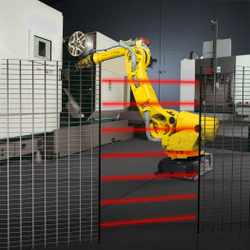
Posted to News on 2nd Oct 2014, 15:43
Top ten tips for operative safety when working alongside robots
Darren Whittall, technical manager at Fanuc UK, offers his top ten tips while explaining why operative safety should be a priority in all robotic applications, and suggests steps that can be taken to avoid robot-related accidents when humans are sharing the same workspace.

The following top ten tips cover regulations, standards, safeguards and other issues relating to robot-operative interactions. However, if in doubt, please contact Fanuc for assistance.
- Scope out all potential hazards - Safety risks will vary depending on your chosen robot and application. Start with a well-documented risk assessment. It is worth noting that most robot-related accidents occur during non-routine operating conditions (for example, operators entering the cell for programming, maintenance, testing, setup or adjustment tasks.
- Revisit the regulations - The Health and Safety Executive (HSE) offers industrial robot safety guidance in its HSG43, Industrial Robot Safety publication. International standards are set out in EN ISO 10218 - Part 1 Robots and robotic devices - Safety requirements for industrial robots, while EN ISO 10218 - Part 2 goes into more detail about robot systems and integration.
- Use simulation software to plan and test robotic concepts - As well as flagging potential new-build issues, software, like Fanuc UK's ROBOGUIDE, can model all of the variable robotic movements, obstacles and potential collision scenarios, in a 3D virtual world.
- Introduce safeguards - Seek expert guidance when building a safety-related control system (SRCS) early in the design phase, as there are many different concepts to consider, including whether your SRCS should be a dedicated system or integrated within your robot controller or robot safety software.
- Provide employees with clear instructions - Reduce the risks of incidents by ensuring your employees receive regular operator training and are issued with appropriate personal protective equipment (PPE).
- Consider the cost benefit and effectiveness of software-enabled technology - Commonplace in the automotive sector, having less hardware means that safety can be integrated more cost-effectively - up to 50 per cent cost-reduction is possible for a small single robot with multiple safety devices. Fanuc's DCS software can monitor the robot's position and speed. The removal of limit and zone switches also makes workcell configurations tighter and simpler.
- Create adaptive zones - It is now possible to programme, enable and disable the zone that the robot can or cannot enter, depending on the task in-hand. This feature, available through DCS Position Check, is especially useful for compact cell configurations.
- Define maximum robot speed - This can be done during normal operation or adjusted to a defined event, enabling an operator to work safely within the proximity of the robot. Fanuc's DCS Speed Check monitors the speed of the robot, ensuring the whole robot, including the end-effector, remains motionless when required.
- Compliance with machine safety standards - Check whether your system meets the PL (performance level) safety standards specified in BS EN ISO 13849-1. As a benchmark, Fanuc's DCS Position and Speed Check functions are certified to PL d and Safe IO Connect to PL e.
- Stay on top of your safety requirements - In today's fast-paced manufacturing environments, robotic workcells and plant layouts evolve quickly. It means constantly revisiting and modifying your safety considerations. With software being more flexible and simpler to upgrade and integrate, this is when a software-based robot comes into its own.
For more information about worker safety around robots, please visit www.fanuc.eu.






























